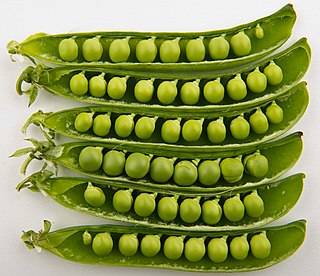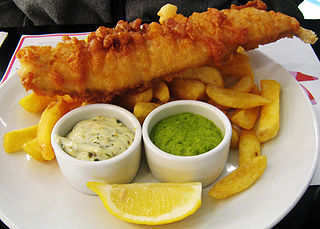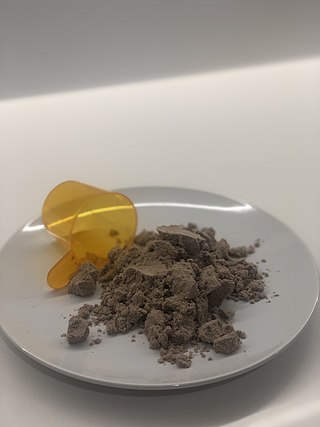
Pea is a pulse, vegetable or fodder crop, but the word often refers to the seed or sometimes the pod of this flowering plant species. Carl Linnaeus gave the species the scientific name Pisum sativum in 1753. Some sources now treat it as Lathyrus oleraceus; however the need and justification for the change is disputed. Each pod contains several seeds (peas), which can have green or yellow cotyledons when mature. Botanically, pea pods are fruit, since they contain seeds and develop from the ovary of a (pea) flower. The name is also used to describe other edible seeds from the Fabaceae such as the pigeon pea, the cowpea, the seeds from several species of Lathyrus and is used as a compound form for example Sturt's desert pea.

α-Linolenic acid, also known as alpha-linolenic acid (ALA), is an n−3, or omega-3, essential fatty acid. ALA is found in many seeds and oils, including flaxseed, walnuts, chia, hemp, and many common vegetable oils.

Legumes are plants in the family Fabaceae, or the fruit or seeds of such plants. When used as a dry grain for human consumption, the seeds are also called pulses. Legumes are grown agriculturally, primarily for human consumption, but also as livestock forage and silage, and as soil-enhancing green manure. Well-known legumes include beans, chickpeas, peanuts, lentils, lupins, mesquite, carob, tamarind, alfalfa, and clover. Legumes produce a botanically unique type of fruit – a simple dry fruit that develops from a simple carpel and usually dehisces on two sides.

The jackfruit is a species of tree in the fig, mulberry, and breadfruit family (Moraceae). The jackfruit is the largest tree fruit, reaching as much as 55 kg in weight, 90 cm in length, and 50 cm (20 in) in diameter. A mature jackfruit tree produces some 200 fruits per year, with older trees bearing up to 500 fruits in a year. The jackfruit is a multiple fruit composed of hundreds to thousands of individual flowers, and the fleshy petals of the unripe fruit are eaten.

Cress, sometimes referred to as garden cress to distinguish it from similar plants also referred to as cress, is a rather fast-growing, edible herb.

Phaseolus vulgaris, the common bean, is a herbaceous annual plant grown worldwide for its edible dry seeds or green, unripe pods. Its leaf is also occasionally used as a vegetable and the straw as fodder. Its botanical classification, along with other Phaseolus species, is as a member of the legume family, Fabaceae. Like most members of this family, common beans acquire the nitrogen they require through an association with rhizobia, which are nitrogen-fixing bacteria.

Mushy peas are dried marrowfat peas which are first soaked overnight in water with baking soda, and then rinsed in fresh water, after which the peas are gathered in a saucepan, covered with water, and brought to a boil, and then simmered until the peas are softened. The mush is seasoned with salt and pepper.

The snap pea, also known as the sugar snap pea, is an edible-pod pea with rounded pods and thick pod walls, in contrast to snow pea pods, which are flat with thin walls. The name mangetout can apply to snap peas and snow peas.

Pease pudding, also known as pease porridge, is a savoury pudding dish made of boiled legumes, typically split yellow peas, with water, salt and spices, and often cooked with a bacon or ham joint. A common dish in the north-east of England, it is consumed to a lesser extent in the rest of Britain. In Newfoundland, it retains its traditional name as part of the customary Jiggs dinner. In non-English speaking countries, similar dishes exist under different names.
Soup beans is a term common in the Southern United States, particularly the regions around the Appalachian Mountains. Soup beans are usually served with cornbread, greens, and potatoes and may be topped with raw chopped onions or ramps. Soup beans are considered a main course, but also serve as a side dish. In rural areas, where food was scarce during the winter, these dried beans were a staple food.
Sativa, sativus, and sativum are Latin botanical adjectives meaning cultivated. It is often associated botanically with plants that promote good health and used to designate certain seed-grown domestic crops.

Split peas are an agricultural or culinary preparation consisting of the dried, peeled and split seeds of Pisum sativum, the pea.
Black peas, also called parched peas or dapple peas, are cooked purple-podded peas. They are a traditional Lancashire dish usually served with lashings of malt vinegar, and traditionally on or around Bonfire Night. The dish is popular in Bury, Preston, Rochdale, Oldham, Wigan, Bolton, Atherton, Tyldesley, Leigh and Heywood. The dried peas are soaked overnight and simmered to produce a type of mushy pea. Parching is a now-defunct term for long slow boiling.
Princes Group is an international food and drink group involved in the manufacture, import and distribution of branded and customer own-brand products. Founded in 1880 and headquartered in the UK, and recently acquired by Newlat Food S.p.A.

The snow pea is an edible-pod pea with flat pods and thin pod walls. It is eaten whole, with both the seeds and the pod, while still unripened.

Pea protein is a food product and protein supplement derived and extracted from yellow and green split peas, Pisum sativum. It can be used as a dietary supplement to increase an individual's protein or other nutrient intake, or as a substitute for other food products. As a powder, it is used as an ingredient in food manufacturing, such as a thickener, foaming agent, or an emulsifier.
A pea is a small spherical seed or the seed-pod of various plants commonly used as a source of food, particularly Pisum sativum.

In Indian cuisine, dal, parippu, pappu, or paruppu are dried, split pulses that do not require soaking before cooking. India is the largest producer of pulses in the world. The term is also used for various soups prepared from these pulses. These pulses are among the most important staple foods in South Asian countries, and form an important part of the cuisines of the Indian subcontinent.

Pea soup or split pea soup is soup made typically from dried peas, such as the split pea. It is, with variations, a part of the cuisine of many cultures. It is most often greyish-green or yellow in color depending on the regional variety of peas used; all are cultivars of Pisum sativum.














